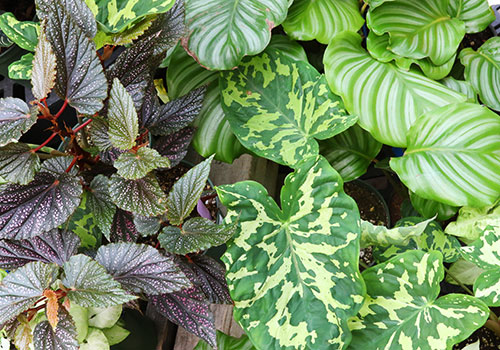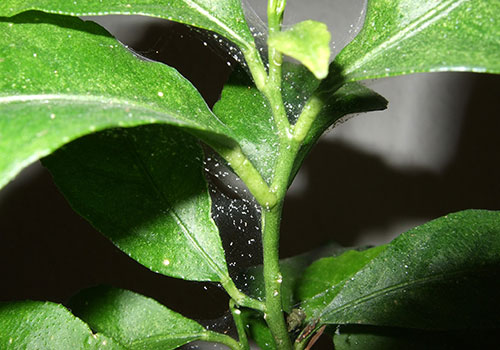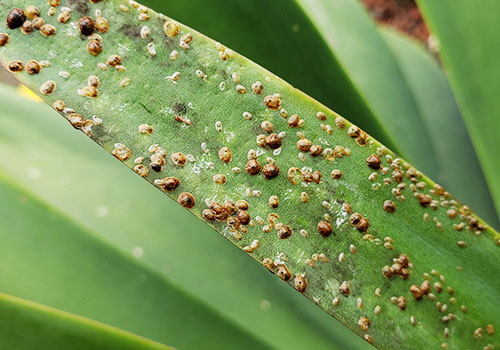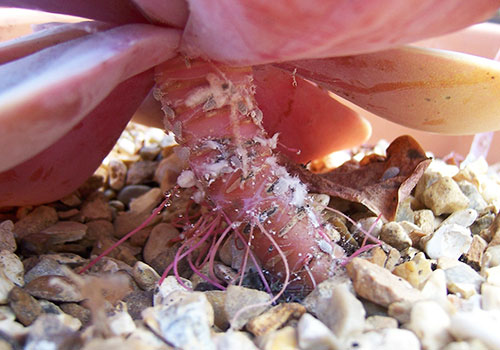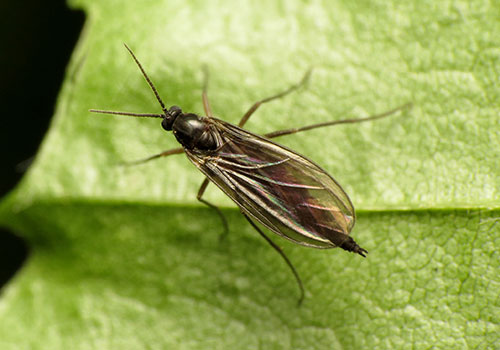Natural Pest Management for Indoor Plants
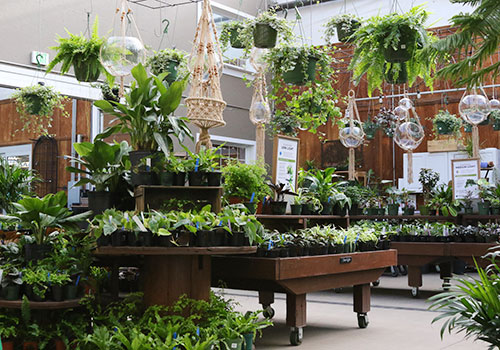
Where there are plants, you can be certain there will be pesky creatures looking to munch on them. Unfortunately for indoor plant parents, this holds true even inside our homes. But that doesn't mean you can't be prepared, and minimize any harm that may befall your plants.
Where Do Indoor Pests Come From?
Even if you haven’t bought a new houseplant in years, you could still find yourself with a sudden and unexpected infestation. Things like open doors and windows, cut flowers and produce, potting soil, and even other insects like ants can all be vectors, or points of infection/transmission.
Here at Sky, we are always on the lookout for any sign of potential issues in our greenhouse because it is our goal to sell only pest-free plants. We recommend that you examine plants you buy from any source before you bring them home as well. Different suppliers have different levels of diligence about checking their plants, and it’s always possible for tiny insects or eggs to sneak past even the most attentive observer.
No one can catch every single little bug that might make its way through your door. So while diligence can help, every indoor gardener needs to know what to do when pests eventually happen.
The Basics of Indoor Pest Management
Happy and healthy plants are often able to mount their own defenses against pest invaders, so make sure to research your plants’ needs and take excellent care of them. Under or over watering, providing too much or too little sunlight, keeping your home too cold, or placing plants where they’ll encounter sudden changes of temperature can all contribute to pest problems.
Catching infestations early is the best way to keep them small and manageable. And the best way to catch an issue early is to spend time with your plant friends every day, or at least as often as your schedule allows.
When you do spot some unwelcome visitors, the first thing to do is to move them away from your other plants. Treating one or two plants is much easier than dealing with an infestation throughout your entire indoor jungle. Set up a quarantine room stat!
As with outdoor pests, it’s best to use the least toxic solution that will work for your pest problem. After all, there’s no reason to add potentially harmful chemicals to your home if something natural is all you need. In some cases, just changing the humidity or the way you’re watering can clear up an issue. Other times, a little soap and water or rubbing alcohol can do the trick.
An important reminder going forward: always disinfect your pruning tools and the tip of your watering can between caring for infected and healthy houseplants.
Finally, make sure you know exactly which pest you’re dealing with! That’s where the rest of this post, and of course the awesome indoor gardening staff at Sky, can help you out. As a starting point, let’s cover the three most common types of indoor pests we hear about, and our suggestions for dealing with them.
Spider Mites
Photo - Paremecium, Wikipedia
It is very difficult to spot these pinhead-sized arachnids, so you’ll likely see their calling cards before you see the creatures themselves. Like their namesakes, they produce webbing, which they use for transportation and protection. If you’re lucky, you’ll spot their silken strands before they have a chance to do much damage, so this will be the first sign you’ll see.
If you’re less lucky, you might instead notice a stippled pattern of yellowing in your leaves. Spider mites have straw-like mouthparts that they use to suck the good stuff out of your leaves, leaving behind tiny yellow spots. A single spider mite can’t cause much damage, but since they reproduce quickly, an unchecked colony can quickly lead to defoliation by a thousand pinpricks.
If you have a large plant and you see webbing concentrated on certain parts of it, you can use clean pruners to remove those sections and dispose of them in the trash. If the infestation seems to be affecting the whole plant, you can gently wash it with biodegradable soap, or spray all of its surfaces with neem oil. (Be sure to follow recommended application instructions on bottle, to ensure that you completely eliminate pests at every stage of their life cycle, eggs to adults.)
Spider mites can easily travel to other plants by flying through the air on silk threads, so make sure to keep affected plants isolated until you’re certain your plants are healthy again.
Scale & Mealybugs
Photo 1 - Public Domain, Photo 2 - Jacopo Werther, Wikimedia
These two closely related pests behave similarly, and the way to deal with them is similar too. The biggest differences are: scale are coated in dark-colored shells whereas mealybugs look fuzzy and white, and mealybugs reproduce in a matter of weeks whereas the scale lifecycle takes a couple of months.
It can be easy to mistake these pests for a disease or just strange growths at first, because they are nearly invisible in their nymph stage and they very rarely move once they reach adulthood. Look for raised bumps in the nooks and crannies between branches, especially on fresh new growth. Even with proper care, plants that are struggling with scale or mealybug infestations may look wilted and depleted, and in advanced cases, may even lose their leaves.
These insects know how to hold on tight, but swabbing them with rubbing alcohol will force them to let go. Soak a cotton swab and hold it to the insects until you can remove them. Once you have carefully removed all of the adults, you can wash your plant with biodegradable soap or spray it with neem oil to get rid of any remaining eggs or nymphs. (Once again, follow recommended application instructions on bottle)
Fungus Gnats
Photo - Katja Schulz, Flickr
Adult fungus gnats don’t hurt your plants: they don’t have time to do much besides reproduce and then die. But unfortunately their larvae tend to voraciously gobble up any and all organic matter they can find in your potting soil, including plant roots!
You will probably see the adults first. They look like fruit flies, and they swarm up out of containers when you water or jostle your plants. You might also notice your plants failing to thrive if larvae have already done some root damage.
The good news is that fungus gnats need moist soil at the surface of your plants’ pots in order to survive and thrive. Most plants can tolerate drying out a bit between waterings, and many even prefer it, so let the soil dry out as much as you can without harming your plants. When you do need to water, place a tray of water underneath your plant pot rather than watering from the top. That way, your plants can get a drink but you won’t be laying out a gnat welcome mat.
You can trap adult gnats with a sticky paper trap to slow down their reproduction. Meanwhile, drench the soil with diluted hydrogen peroxide or neem oil to kill larvae and eggs. Dilute your average drugstore hydrogen peroxide with four times the amount of water, or follow the package instructions for a neem oil soil drench. Monitor your plants for a few weeks to make sure you have completely eradicated the gnats.
Cheers to Healthy Plants!
Pests can be a challenge, but once you know how to manage them, you can get right back to enjoying the company of your leafy friends. Once pests have been defeated and you've waited a couple of weeks to make sure they aren’t coming back, you can triumphantly move your plants back to their favorite spots. Maybe even give them a little fertilizer as a treat, and don’t forget to pat yourself on the back!
